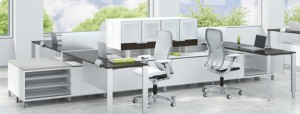In another informative white paper from Allsteel, you can learn about the importance of work targeting. That’s one of those phrases invented to describe something that everyone does without realizing it. When you sit in your chair and look at your desk, your eyes go directly to your monitor. That’s why you want your monitor to be at just the right height for easy viewing.
But what if you lean back in your chair? The recline feature may be comfortable, but it can bring your head out of alignment with your ‘target’ so you are looking up at your monitor instead of straight at it. You may also be moving your head too far away from your monitor (and moving your hands too far from your keyboard). This is counterproductive from an ergonomic standpoint since it encourages abnormal positioning and movements during work.
Allsteel’s solution to this problem was to develop a recline mode for their Sum chair that allows relaxation without significantly moving the upper body. This promotes continuous, accurate work targeting throughout the day.


